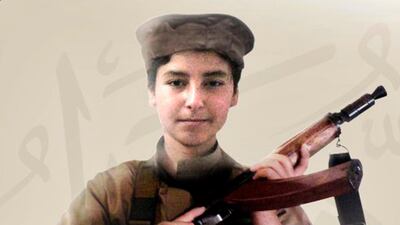May Allah Accept him, reads a tribute on a poster announcing the identity of ISIS' latest "martyr". Sporting a Pakol - the flattened cap more commonly associated with the tribes of Afghanistan and Pakistan than the once cosmopolitan cities of western Syria, a baby-faced jihadist with a steely gaze and an automatic rifle poses square to the camera.
But this is no rank and file fighter. This is the son of ISIS leader Abu Bakr Al Baghdadi, killed in battle in Syria, the poster claims.
Distributed via Telegram on July 3, the poster says Huzaifa Al Badri was killed in an operation in Syria's Homs province in an attack on a power plant held by the Syrian regime with the support of Russian forces. It claims Al Badri was killed fighting as an inghamasi, the name given to an operation wherein an insurgent fights until they can no longer fight – be that to the death, or to some miraculous victory.
One security source told The National, that the use of Al Badri in such an attack represents an effort to combat divisions that have surfaced within the group since its loss of Mosul and Raqqa last year. "It's likely a symbolic gesture to curb in-fighting from those who demand to see Al Baghdadi still alive and committed to the cause".
___________
Read more:
In post-ISIS Iraq, tribal justice grows in shadow of Baghdad mistrust
Donald Trump lauds capture of five top ISIS commanders
___________
Iraqi security analyst Hisham Al Hashemi noted on Twitter that Al Badri had last been seen in September 2017 in the town of Hajin in eastern Syria, with his father’s bodyguard Abdullatif Al Jabouri.
Hajin is one of the few areas of territory openly held by ISIS, and it remains at the heart of the military coalition's efforts to combat the group. Last month, some 45 members of the group were killed in an airstrike after gathering in the town for a meeting. It is one of the last places where the black flag flies openly.
Security officials suspect the group number is up to 800 in the largely abandoned town – likely outnumbering the remnants of the local population – an indicator of the group’s failed governance project. Hajin is no more a state than it is a backwater hideout.
But while the group has been rolled back and Al Baghdadi has seemingly vanished, there is evidence they are attempting to infiltrate other parts of Syria. As a western security source told The National, "there are growing numbers of ISIS still entering Idlib, and Suwayda in southern Syria – Suwayda was recently featured on the front of Al Naba [the group's newsletter], I can't recall it coming to the fore like this".
Little is known about the personal life of Al Baghdadi, or those close to him, but Mr Al Hashemi notes that Al Badri was born in 2000, in the Iraqi city of Samarra, to Asma Fawzi Al Qubaisi, the first of the caliph’s three wives.
The location of Al Badri’s martyrdom, in Syria’s government controlled west, might serve as something of a surprise to those following the efforts to hunt down Al Baghdadi. Hitherto, much of the hunt for the so-called caliph, who has a $25 million (Dh98.1 million) bounty on his head, has focused on the arid desert straddling the Syrian-Iraqi border. The long-standing assumption being that as the caliphate’s territory receded, deeper into it the caliph retreated.
Intelligence officials have confirmed Al Baghdadi was seriously injured in a coalition airstrike near the town of Shirqaat in Iraq in early 2015. Earlier this year, The Guardian reported that in 2016, as the battle for Mosul began, a slip-up in which he spoke on an unsecured radio line for 45 seconds saw him traced to a small village between Mosul and Tel Afar.
More recently there was a confirmed sighting on the Syrian side of the border in the town of Albu Kamal during Ramadan 2017.
His last public statement came in September 2017, in an audio recording released online. To this day, the only video footage of him remains his ascending the pulpit in Mosul’s Al Nuri mosque, the iconic video in which he bestowed on himself the title of caliph – days later the "Islamic state of Iraq and Syria" was officially announced.
Much of the group’s senior leadership have gone to ground, or been killed on the battlefield. But there has been limited success in hunting them down.
In March, five senior ISIS officials were lured across the border from Syria into Iraq in a daring operation by Iraqi and American intelligence services, they now await trial in Baghdad.
Dead or alive, the caliph continues to evade, perhaps his son’s death suggests the world has been looking in the wrong place.


